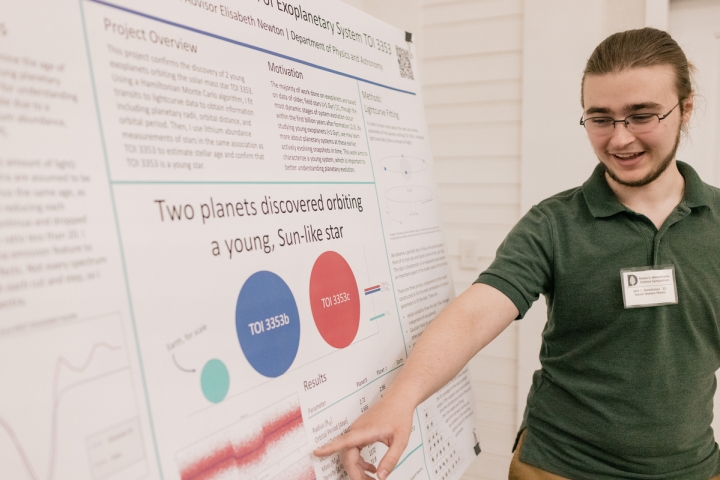Using data collected by NASA’s Transiting Exoplanet Survey Satellite, Jack Duranceau ’23 this year added two new planets to the rapidly growing roster of such celestial bodies found in the universe.
Because they are outside our solar system, they are known as exoplanets, and more than 5,000 have been confirmed over the years, according to NASA.
TOI 3353b and TOI 3353c are almost three times the size of the Earth, but orbit close to their young, sun-like host star, TOI 3353, which is 257 light years away from us.
By comparison, the sun is 8.2 light minutes from Earth, and the next-closest star, Proxima Centauri, is 4.25 light years away.
“A lot of what we know about exoplanets is based on data from older systems,” says Duranceau, a physics and astronomy double major who graduated at Commencement.
“Finding planets in a young system is exciting. It’s a chance to better understand planetary evolution,” he says.
Launched in 2018, NASA’s exoplanet survey satellite is a space telescope that is designed to survey the brightest stars in the sky, monitoring them for periodic drops in brightness—the telltale sign of one or more planets that may be orbiting the star and blocking some their light as they pass by.
“These become planet candidates, but in order to be confirmed planets, they need some extra attention from astronomers,” says Duranceau.
He developed, as part of his undergraduate thesis project, a computer model of the exoplanet system that simulates how the star’s brightness would vary on account of orbiting planets with certain estimated physical parameters, including size, period of revolution, and orbital radius. These physical parameters are iteratively adjusted until the algorithm can find a model of the exoplanet system whose light curve matches the observed data.
“One thing about young planets that makes things difficult is that their young, host stars are very variable. They have spots on their surfaces that create a lot of changes in the stellar brightness,” says Duranceau’s project adviser, Elisabeth Newton, an assistant professor of physics and astronomy.
The drop in brightness from transiting planets is rather small. So looking at the data in a way that also accounts for the stellar variability while distinguishing the planets’ effect on brightness is a very important and challenging part of the process, says Newton, who co-leads the TESS Hunt for Young and Maturing Exoplanets collaboration.
“As far as looking for analogs within our own solar system, Neptune is probably the closest to these exoplanets in size and density,” says Duranceau.
What’s intriguing is their proximity to the host star, he says. Whereas Earth and Mercury are 94 million and 37.2 million miles from the sun, respectively, these planets are only 4.6 million and 7.4 million miles from their star.
“These are pretty comparable to the icy giants in the outer solar system,” says Duranceau. “Why are they so close?”
In addition to confirming the discovery of the planets and working out their physical characteristics, Duranceau also ascertained the age of the system around TOI 3353a, the host star. For this, he worked with spectral data collected by the South African Large Telescope, Dartmouth’s major ground-based facility.
The age of a star can be determined with information about its temperature and the abundance of the element lithium, which can be extracted from its spectrum. Using this method, Duranceau made the most accurate estimate of age yet for TOI 3353a—it is about 22.8 million years old.
“Not only did he independently work out how to identify the most appropriate data and make measurements, but he also came up with a way to make the process faster,” says Newton.
Duranceau, who grew up in Quechee, Vt., is staying on at Dartmouth for a year to wrap up work on the project. He later hopes to pursue a PhD in astronomy.
